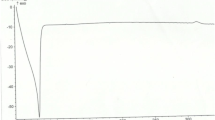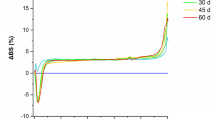Abstract
The objective of the present study was to investigate the effect of partially hydrolyzed ginsenoside on the physicochemical properties and in vitro release of curcumin from phospholipid-based nanostructured lipid carrier (NLC). NLC formulas modified with partially hydrolyzed ginsenoside (NLC-PG) were prepared with different amounts of ginsenoside using the conventional hot-melt method. The average particle size of curcumin-loaded NLC-PG ranged from 150 to 200 nm, and polydispersity index was in the range of 0.101–0.177, indicating monodispersed particle size distribution. Optical microscopy showed no sedimentation or recrystallization of curcumin even at 10,000 μg/ml concentration as NLC-PG in distilled water, indicating significantly enhanced solubility. TEM image showed that the nanoparticles were monodispersed with a multilayered core/shell structure. X-ray diffraction and FTIR spectroscopy showed that curcumin was amorphous in the NLC-PG, and there was no interaction between curcumin and the excipients. In vitro release study using simulated gastric/intestinal fluid media revealed that the release rate (Jss) of curcumin from the NLC-PG increased as a function of the ginsenoside content in the lipid carrier. Moreover, the Jss of curcumin kept gradually increasing in the presence of lipase, whereas in the presence of viscozyme, it sharply increased until the ginsenoside content reached 9.09% and subsequently plateaued. Partially hydrolyzed ginsenoside increased the Jss of curcumin from curcumin-loaded NLC-PG and therefore may be useful for improving the bioavailability of curcumin.






Similar content being viewed by others
References
de Almeida M, da Rocha BA, Francisco CRL, Miranda CG, Santos PDF, de Araujo PHH, et al. Evaluation of the in vivo acute antiinflammatory response of curcumin-loaded nanoparticles. Food Funct. 2018;24:440–9.
Waly MI, Al-Bulushi IM, Al-Hinai S, Guizani N, Al-Malki RN, Rahman MS. The protective effect of curcumin against nitrosamine-induced gastric oxidative stress in rats. Prev Nutr Food Sci. 2018;23:288–93.
Choi YH, Han DH, Kim SW, Kim MJ, Sung HH, Jeon HG, et al. A randomized, double-blind, placebo-controlled trial to evaluate the role of curcumin in prostate cancer patients with intermittent androgen deprivation. Prostate. 2019;79:614–21.
Tajbakhsh A, Hasanzadeh M, Rezaee M, Khedri M, Khazaei M, ShahidSales S, et al. Therapeutic potential of novel formulated forms of curcumin in the treatment of breast cancer by the targeting of cellular and physiological dysregulated pathways. J Cell Physiol. 2018;233:2183–92.
Vijayakumar A, Baskaran R, Maeng HJ, Yoo BK. Ginsenoside improves physicochemical properties and bioavailability of curcumin-loaded nanostructured lipid carrier. Arch Pharm Res. 2017;40:864–74.
Asai A, Miyazawa T. Occurrence of orally administered curcuminoid as glucuronide and glucuronide/sulfate conjugates in rat plasma. Life Sci. 2000;67:2785–93.
Berginc K, Trontelj J, Basnet NS, Kristl A. Physiological barriers to the oral delivery of curcumin. Pharmazie. 2012;67:518–24.
Kunihiro AG, Brickey JA, Frye JB, Luis PB, Schneider C, Funk JL. Curcumin, but not curcumin-glucuronide, inhibits Smad signaling in TGFβ-dependent bone metastatic breast cancer cells and is enriched in bone compared to other tissues. J Nutr Biochem. 2019;63:150–6.
Mourtas S, Lazar AN, Markoutsa E, Duyckaerts C, Antimisiaris SG. Multifunctional nanoliposomes with curcumin-lipid derivative and brain targeting functionality with potential applications for Alzheimer disease. Eur J Med Chem. 2014;80:175–83.
Lin YH, Lin JH, Hong YS. Development of chitosan/poly-γ-glutamic acid/pluronic/curcumin nanoparticles in chitosan dressings for wound regeneration. J Biomed Mater Res B Appl Biomater. 2017;105:81–90.
Popat A, Karmakar S, Jambhrunkar S, Xu C, Yu C. Curcumin-cyclodextrin encapsulated chitosan nanoconjugates with enhanced solubility and cell cytotoxicity. Colloids Surf B Biointerfaces. 2014;117:520–7.
Udompornmongkol P, Chiang BH. Curcumin-loaded polymeric nanoparticles for enhanced anti-colorectal cancer applications. J Biomater Appl. 2015;30:537–46.
Tabatabaei Mirakabad FS, Akbarzadeh A, Milani M, Zarghami N, Taheri-Anganeh M, Zeighamian V, et al. A comparison between the cytotoxic effects of pure curcumin and curcumin-loaded PLGA-PEG nanoparticles on the MCF-7 human breast cancer cell line. Artif Cells Nanomed Biotechnol. 2016;44:423–30.
Guo F, Wu J, Wu W, Huang D, Yan Q, Yang Q, et al. PEGylated self-assembled enzyme-responsive nanoparticles for effective targeted therapy against lung tumors. J Nanobiotechnology. 2018;16:57.
Guo F, Guo D, Zhang W, Yan Q, Yang Y, Hong W, et al. Preparation of curcumin-loaded PCL-PEG-PCL triblock copolymeric nanoparticles by a microchannel technology. Eur J Pharm Sci. 2017;99:328–36.
Szymusiak M, Hu X, Leon Plata PA, Ciupinski P, Wang ZJ, Liu Y. Bioavailability of curcumin and curcumin glucuronide in the central nervous system of mice after oral delivery of nano-curcumin. Int J Pharm. 2016;511:415–23.
Zheng B, Peng S, Zhang X, McClements DJ. Impact of delivery system type on curcumin bioaccessibility: comparison of curcumin-loaded nanoemulsions with commercial curcumin supplements. J Agric Food Chem. 2018;66:10816–26.
Gota VS, Maru GB, Soni TG, Gandhi TR, Kochar N, Agarwal MG. Safety and pharmacokinetics of a solid lipid curcumin particle formulation in osteosarcoma patients and healthy volunteers. J Agric Food Chem. 2010;58:2095–9.
Cuomo J, Appendino G, Dern AS, Schneider E, McKinnon TP, Brown MJ, et al. Comparative absorption of a standardized curcuminoid mixture and its lecithin formulation. J Nat Prod. 2011;74:664–9.
Vareed SK, Kakarala M, Ruffin MT, Crowell JA, Normolle DP, Djuric Z, et al. Pharmacokinetics of curcumin conjugate metabolites in healthy human subjects. Cancer Epidemiol Biomark Prev. 2008;17:1411–7.
Vijayakumar A, Baskaran R, Baek JH, Sundaramoorthy P, Yoo BK. In vitro cytotoxicity and bioavailability of ginsenoside-modified nanostructured lipid carrier containing curcumin. AAPS PharmSciTech. 2019;20:88.
Clayton KN, Salameh JW, Wereley ST, Kinzer-Ursem TL. Physical characterization of nanoparticle size and surface modification using particle scattering diffusometry. Biomicrofluidics. 2016;10:054107.
Chen J, Qin X, Zhong S, Chen S, Su W, Liu Y. Characterization of curcumin/cyclodextrin polymer inclusion complex and investigation on its antioxidant and antiproliferative activities. Molecules. 2018;23:1179.
Davis BM, Pahlitzsch M, Guo L, Balendra S, Shah P, Ravindran N, et al. Topical curcumin nanocarriers are neuroprotective in eye disease. Sci Rep. 2018;8:11066.
Cheng KK, Chan PS, Fan S, Kwan SM, Yeung KL, Wang YX, et al. Curcumin-conjugated magnetic nanoparticles for detecting amyloid plaques in Alzheimer’s disease mice using magnetic resonance imaging (MRI). Biomaterials. 2015;44:155–72.
Chen X, Zou LQ, Niu J, Liu W, Peng SF, Liu CM. The stability, sustained release and cellular antioxidant activity of curcumin nanoliposomes. Molecules. 2015;20:14293–311.
Wan S, Sun Y, Qi X, Tan F. Improved bioavailability of poorly water-soluble drug curcumin in cellulose acetate solid dispersion. AAPS PharmSciTech. 2012;13:159–66.
Mohan PR, Sreelakshmi G, Muraleedharan CV, Joseph R. Water soluble complexes of curcumin with cyclodextrins: characterization by FT-Raman spectroscopy. Vib Spectrosc. 2012;62:77–84.
Hu L, Shi Y, Li JH, Gao N, Ji J, Niu F, et al. Enhancement of oral bioavailability of curcumin by a novel solid dispersion system. AAPS PharmSciTech. 2015;16:1327–34.
Jeevana Jyothi B, Sravani R. Development of curcumin nanocrystals and evaluation of GI absorption efficiency in comparison with curcumin and turmeric powder. World J Pharm Pharm Sci. 2016;5:1990–2003.
Song BK, Kim KM, Choi KD, Im WT. Production of the rare ginsenoside Rh2-mix (20(S)-Rh2, 20(R)-Rh2, Rk2, and Rh3) by enzymatic conversion combined with acid treatment and evaluation of its anti-cancer activity. J Microbiol Biotechnol. 2017;27:1233–41.
Choi HS, Kim SY, Park Y, Jung EY, Suh HJ. Enzymatic transformation of ginsenosides in Korean red ginseng (Panax ginseng Meyer) extract prepared by Spezyme and Optidex. J Ginseng Res. 2014;38:264–9.
Acknowledgments
The authors would like to thank Ms. Sun Kyung Choi for her assistance with the in vitro release experiments and manuscript documentations.
Author information
Authors and Affiliations
Corresponding author
Ethics declarations
Conflict of Interest
The authors declare that they have no conflicts of interest.
Additional information
Publisher’s Note
Springer Nature remains neutral with regard to jurisdictional claims in published maps and institutional affiliations.
Rights and permissions
About this article
Cite this article
Selvaraj, K., Yoo, BK. Curcumin-Loaded Nanostructured Lipid Carrier Modified with Partially Hydrolyzed Ginsenoside. AAPS PharmSciTech 20, 252 (2019). https://doi.org/10.1208/s12249-019-1467-z
Received:
Accepted:
Published:
DOI: https://doi.org/10.1208/s12249-019-1467-z




